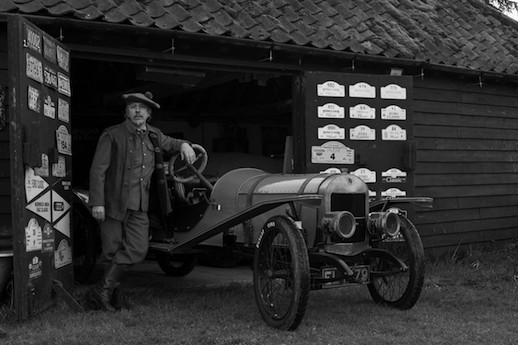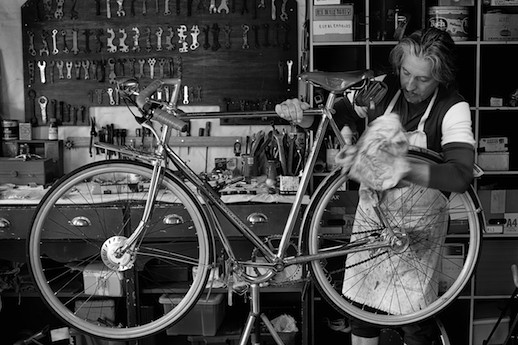 Words and pictures: Dan Richards
Words and pictures: Dan Richards
Cally Callomon (1956– ) spends a certain amount of time within the music industry in order to earn enough money to ride, restore and research ancient bicycles.
Having started out as a musician, he went on to work in A&R and was Creative Director at Island Records throughout the 1990s, working with Tricky, U2, PJ Harvey and Nine Inch Nails among many others. He currently navigates Bill Drummond and manages the estate of Nick Drake.
* * * * *
Cally Callomon
Marlinspike Hall, Walpole, Suffolk
17 August 2010
Writing in a caravan.
Nothing to do but write.
A week alone to write while house-sitting for Cally. Left in charge of the chickens and this van in the woods, green bicycle propped by the door.
Birds fuss on the tin roof above me; landing, dancing, taking off – drumming, tapping, clacking feet. Cars swish out of sight on the Halesworth Road.
At night the poplars roar.
I met Cally through Bill Drummond. Cally is Bill’s manager – which, on paper, looks akin to Rupert Bear managing Sparta Praha but seems to work remarkably well in reality.
Yesterday I spoke to Cally for a good five hours. We sat in his office, took a tour around his house, outhouses and sheds; examined his collections of vintage bicycles and cars, motorbikes, box files, comics, records, signage, baths, and books; the 1930s Parisian bar he’s built in his cellar, the reinforced floors, the dentist’s chair in the bathroom … the man collects on an epic scale and has amassed a palace of interesting things, ‘resource’ of amazing scope.
Graphic Designer, Engineer, Director, Executor, Archivist, Manager, Cyclist, Chameleon, Comedian, Corinthian and Caricature … I wonder, does he sleep?
A moth edges above me to inspect the galley light. A downy grey-brown creature with hair-sprung trembling legs.
18 August
Transcribing, writing things into shape, staring out into Suffolk, making tea on the gas stove. Ideal.
Here I am in a caravan out in the nature, just me. Nothing to do but write; write and consider writing … mainly the latter as it turns out.
I sit in the moment of ‘about to start writing’ for a long time, listening back to tapes of conversations I’ve collected about creativity … I sit there, stalled. Inert. The world’s most unproductive writer, neither writing himself nor transcribing the thoughts of prolific virtuosos.
A caravan. A week. Nothing to do but write.
I have my books, I have a good pen, I have my Mac – and no internet to distract me. I’ll brew up and set about it, I think. This Suffolk caravan is just the thing.
But then I go back to staring, half listening to the tapes, distractedly tinkering with the same three sentences – staring out of the window or down at the caravan’s carpet … which rings a bell. Carpet. Didn’t I record something off the radio about carpet, a while ago? Carpet and process?
‘He would come out of his study, take hold of the carpet sweeper – which was right next to his study door – and start sweeping the hallway …’
Carpet.
‘The carpet sweeper served a very important function. Daddy had a routine – he would get up quite early in the morning, have breakfast, always do the Times crossword and then settle down to write at his typewriter for the morning and, as a way of pausing, he would come out of his study, take hold of the carpet sweeper – which was right next to his study door – and start sweeping the hallway for, I don’t know, a few minutes …’
J.G. Ballard’s carpet.
‘And then go back to his study and do a bit more typing. He’d come out again half an hour later and do a bit more – maybe a couple of hours later he’d come out again, do a bit more – so I think, in a sense, the use of the carpet sweeper was really a device to stop and reflect on what he’d been writing.’ [Fay Ballard, Front Row, BBC Radio 4, 10 February 2010]
I look at my notes, those three mangled sentences – pulled apart distractedly as cats bat mice – and I shudder and agree with the ghost of J.G. Ballard’s carpet sweeper that, yes, this is shambolic and I really must get cracking; that transcription is the writing equivalent of laboriously mixing paint before the painting proper can begin … that the drudge has to come before the fun stuff.
‘I’ve only got a week to really crack on,’ I think, glumly.
Then I cycle to Southwold instead.
Cally stands before his bicycles. A racing penny-farthing with slender sharp front forks, a hammock saddled Pedersen with a silver welded frame – one particularly hefty example was designed to be parachuted into Normandy over the shoulders of the invading SAS, who were doubtless pleased when that those plans were shelved in the run-up to D-Day.
Dressed in an apron, hair swept back, work boots, turn-ups, shirt sleeves rolled, every inch the artisan, he runs me through the cycle’s evolution, illustrating each advance with reference to his collection, many of which he’s built or restored to exacting specs, all operable and ridden – if he doesn’t use a bike, it goes, swapped or sold on; utility exemplified, form and function fused.
Over in his office I am shown some more ‘resource’. An annex from the main house, the interior of this solid double-decker shed is stacked out, a massive cache of ‘stuff’ and ‘things’ and ‘data’ … an asset battery: floor to ceiling, stowed, boxed and catalogued. Resource is the panacea. Resource is anything and everything that could be of use. Resource is the very thing you do/might/could/shall want. This is Cally’s brain manifest:
‘This is where a lot of the design resource stuff is. Upstairs I’ve got folders and folders full of clippings; every time I read a magazine, if there’s something in it that I like, I cut it out and file it under subject matter.’
When did that start?
‘When I was at art school, because at art school they had filing cabinets with Hands/Faces – resource material really for being an artist. If you were doing a piece of advertising and you needed a hand holding a book, you’d either get someone to hold their hand and you’d draw it or you’d find a picture of a hand and copy the picture because if you were in advertising you had to hand-draw visuals with magic markers to say “This is what the advert would look like” and, because it was a graphic design course, they tried – rather humorously – to do visuals quickly. Some people were brilliant at it but I was absolutely hopeless so I thought, “Well, if I just collect all this stuff, I’ll be able to collage it together and it will have a nice quality all of its own.” That was 1974/5 when I started to collect and I’ve had this enormous amount of stuff which has followed me round: articles about fairgrounds, articles about outsiders. I’ve got a file that’s just called “Nutters” (laughs). If I read an article in the Evening Standard about some guy who died while hanging off his roof, that would go in there. I don’t know why … it’s partly resource, I do dive into it now and again but I sometimes think – I had to go through a file at the weekend and I thought, “I forgot I had all this stuff.” It does work as stimulus, I suppose, but I think, “What is going to happen to all this when I die?” That’s a silly thing even to think about, you know … it burns. The danger is that you start feeling that it’s an important collection.’
You don’t think somebody else would want it?
‘No. They won’t. There are some bits that people might want, and when Island’s fiftieth anniversary happened this year and they had an exhibition I went through all my Island Records files and I found tonnes and tonnes of stuff that Island hadn’t kept – because I loved the record company and part of loving the record company is collecting the record company, for me. It’s all the ephemera: programmes, packing tape that had the Island logo on, things like that.
My memory is not good, never has been, so everything is filed under headings … but sometimes I forget that boxes exist. I’ve got books of found things – photos that I’ve particularly liked or drawings – (gets down another book, one of his own, and opens it out to show a crumpled doodle) that was on a train, someone’s screwed it up – I think they’d drawn a picture of the ticket collector … (leafing through the scrapbook) I don’t know who the people are, what the story is; letters that I’ve found … (reads from a dog-eared page) “I have enclosed a few snaps. I am not quite so fat as this one.” Brilliant. I get them from car boot sales, wherever … (reading out another find) “Please park further up drive so that others can park. Peter.”
I’ve got a file upstairs of “Angry/Annoyed”, you know? “What kind of fucking parking do you call this?” Stuff like that. People give them to me now.’
* * * * *
‘His house; there is his life’s work,’ says Bill Drummond later, when I ask him about Cally. ‘Working with people like me, the record covers, that’s just to pay the bills.’
* * * * *
The Beechwood Airship Interviews by Dan Richards is published by The Friday Project/HarperCollins and is available now in the Caught by the River shop.
Dan will be appearing with Cally on the Caught by the River Stage at The Good Life Experience in September.
